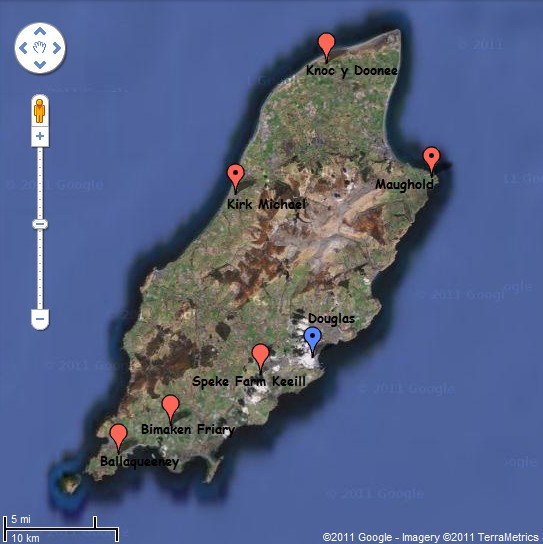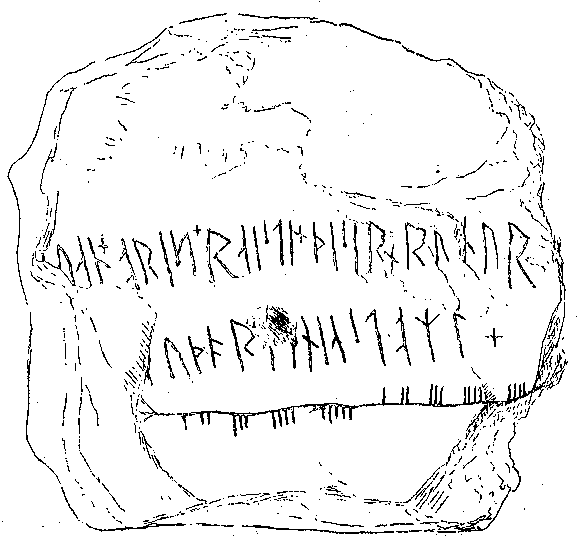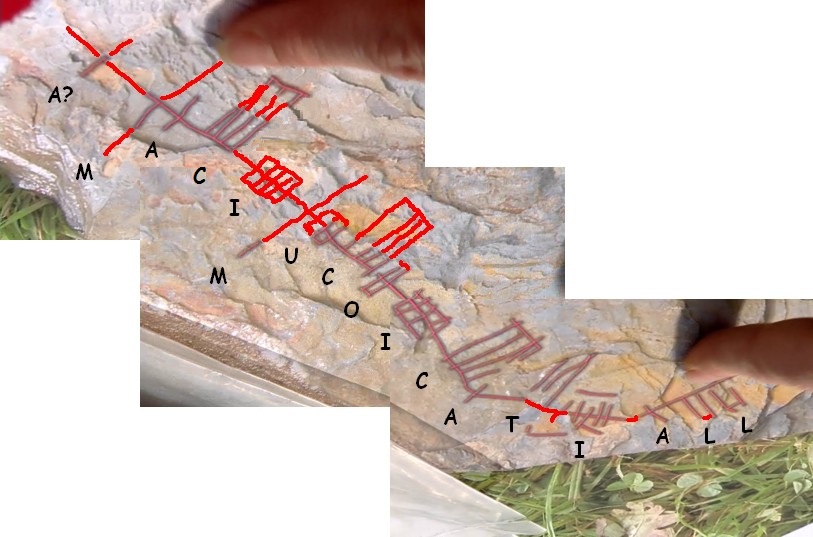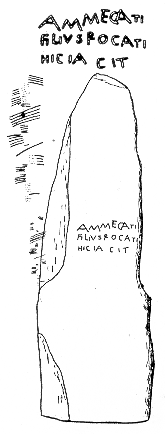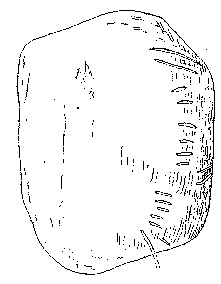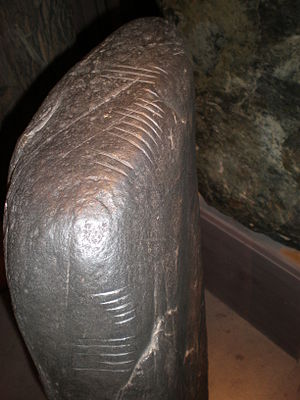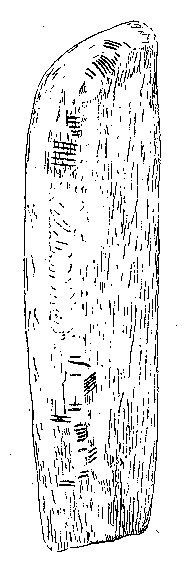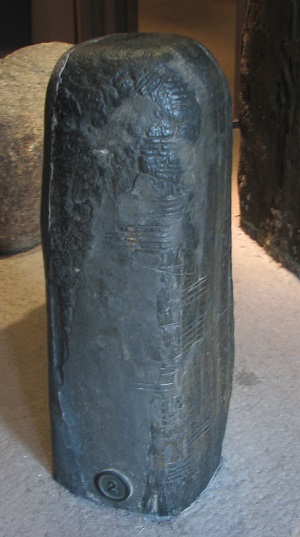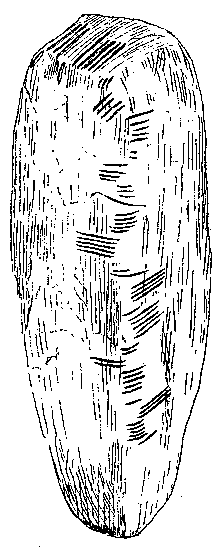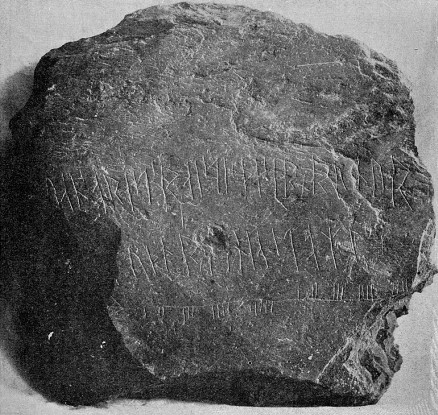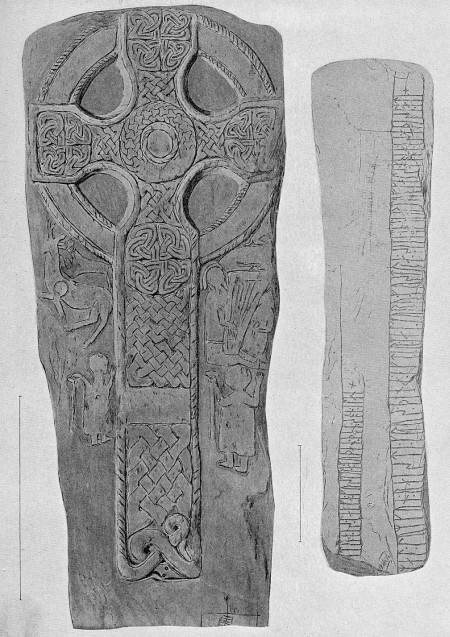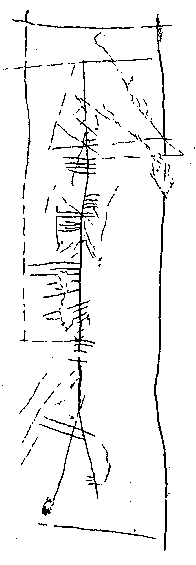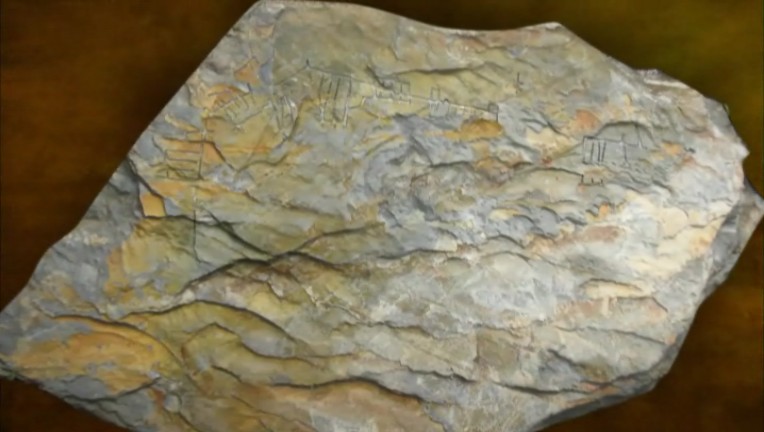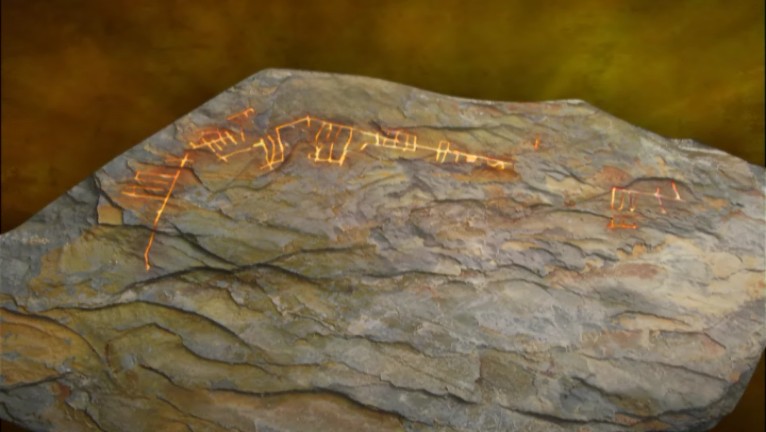BabelStone Blog
Thursday, 30 June 2011
The Ogham Stones of the Isle of Man
- The Ogham Stones of Cornwall and Devon
- The Ogham Stones of Wales
- The Ogham Stones of Scotland
- The Ogham Stones of the Isle of Man
- The Ogham Stones of Ireland
- The Ogham Stones of Elsewhere
The Isle of Man, situated midway between Ireland and Britain, has always been at a sea-faring crossroads, and over the centuries has been exposed to influences from many different cultures. This is well reflected in the relatively large number of monumental inscriptions that have survived on the island, which include both runestones and Ogham stones, exhibiting a mixture of Irish, British, Pictish and Norse influences.
Location of Ogham Inscriptions in the Isle of Man
Red tags mark the sites of certain Ogham inscriptions (a dot indicates that the stone is in situ)
Blue tags mark museums or other sites where Ogham stones are held
The Manx Ogham inscriptions are a heterogeneous group with a wide age span, some perhaps dating to as early as the 5th century, and others dating to as late as the 12th century. Typifying the fusion of Irish and Norse cultures on the island during the medieval period (9th through 13th centuries) are two unique monuments that combine Norse Runic inscriptions and Ogham inscriptions on the same stone :
- Maughold Stone (MAUGH/2)
- Kirk Michael Stone (KMICH/1)
The Maughold stone is a plain, flat stone with a line of Norse runes reading "John the Priest cut these runes" running across its centre, below which is inscribed the sixteen-letter "younger fuþark" in short twig runes. Below that is carved the first ten letters of the Ogham alphabet. Obviously Priest John carved the fuþark, but who carved the parallel Ogham inscription? If you take away the Norse runes the Ogham inscription is awkwardly placed near the edge of the stone, whereas the Norse inscription occupies the centre of the stone, so I do not think that the Ogham letters predate that Norse inscription, but must have been carved at the same time as the Norse runes (maybe Priest John was showing off his skill in both runes and Ogham) or more probably at a later date. Priest John also carved the runes for another inscription that can be dated precisely to 1148, and so the Ogham inscription here must be mid 12th century or later.
Maughold Stone Inscription
Kermode 1910–1911 fig. 5
The Kirk Michael stone is a 11th century decorated cross slab with a long Norse inscription in long branch runes commemorating a foster son. There are faint Ogham inscriptions on both the front and back of the slab, the one on the front comprises the entire Ogham alphabet written in bind letters, but the one on the back is no longer legible (and the 19th century reading cannot be relied on). These two inscriptions are clearly not part of the original monument but must have been scratched on at a later date, probably sometime during the 11th or 12th century.
The fact that both these Norse monuments have been defaced by the addition of the Ogham alphabet is perhaps indicative of Gaelic reaction against the Norse occupiers of the island, and a resurgence of Gaelic nationalism. The use of a "feather mark" at the start of the Maughold inscription and the use of bind letters in the Kirk Michael inscription are indications that the Ogham alphabets scratched onto these stones may have been copied from a manuscript book such as the Auraicept na n-Éces ("Scholars' Primer"), and so they may reflect a pedantic interest in a script that was no longer used for commemorative inscriptions.
In contrast to these unusual, very late Ogham inscriptions, there are a number of fairly typical Irish-style pillar stones with a monoscript inscription in typical Primitive Irish, commemorating people with Goidelic names :
- Bimaken Friary Stone I (ARBRY/1) : CUNAMAGLI MAQ[--] = Of Cunamaglas, son of ...
- Ballaqueeney Stone I (RUSHN/1) : DOVAIDONA MAQI DROATA = Of Dovaido, son of Droata
- Ballaqueeney Stone II (RUSHN/2) : BIVAIDONAS MAQI MUCOI CUNAVA[LI] = Of Bivaidonas, son of the tribe Cunava[li]
These are dated to the 5th or 6th century. Two of these three stones were found in the burial ground of a Keeill, a type of small, early medieval (5th–12th century) Celtic chapel. Large numbers of Keeills are found scattered throughout the island, and the Ogham stones associated with Keeills were probably used as grave markers. One other early stone that was also found in the burial ground of a keeill has a biscript Latin-Ogham inscription :
- Knoc y Doonee Stone (ANDRS/1) : AMBICATOS MAQI ROCATOS = AMMECATI FILIVS ROCATI HIC IACIT = Here lies Ammecatus, son of Rocatus (Latin); Ambicatos, son of Rocatos (Ogham)
The commemoration of a person with both a Latin inscription and an Ogham inscription is a typical feature of the Ogham stones of Southern Britain (Wales and the South-West), but is unknown in Irish Ogham stones. The name Rocatos is probably Goidelic, but his son has a Brittonisized name, Ammecatus or Ambicatos, equivalent to the Irish Imbicatos. Thus, this stone shows evidence of an early (6th century?) mainland British influence on the Irish Manx culture.
One other monoscript Ogham stone is less typical :
- Bimaken Friary Stone II (ARBRY/2) : [--] MAQ LEOG[--] = ..., son of Leog
This stone is an odd, "cheese" shape, quite unlike the pillar stones that Ogham is normally inscribed on, and uses the linguistically late form maq for the earlier maqi, on which basis it has been dated to around the 6th to 9th centuries.
The most recently discovered Manx Ogham stone, discovered in the burial ground of an 11th century keeill during the filming of an episode of Time Team in 2007, is in my opinion the most unusual and most important Ogham stone ever to have been found on the island :
- Speke Farm Keeill Stone : [--][A] MAC[I] MUCOI CATIALL[I] = ..., son of the tribe of Catiallus
The stone is small and flat, and the Ogham inscription is carved using bind letters on an artificial stemline that meanders across the stone's flat surface. Ogham inscriptions on flat stone surfaces are highly unusual outside of Scotland, where they are typical of Pictish Ogham inscriptions. Bind oghams, a form of Ogham writing where the branches of each letter are bound together at their tips, are also a feature that is found on some Pictish Ogham stones, and so although the language of the inscription is Irish rather Pictish, there is probably a Pictish influence on the physical form of this Ogham inscription. Pictish Ogham stones are generally dated somewhat later than the typical Ogham pillar stones, and the linguistically late form maci for the earlier maqi in this inscription confirms that it must have been inscribed at a later date compared with the Ogham pillar stones discussed above.
|
Pictish Bind Ogham Inscription SC1080221 © RCAHMS |
Reconstructed Speke Farm Keeill Inscription |
The stone was found close to a disturbed cist grave, and was probably a memorial for the young adult (about 14–20 years of age) who occupied the grave. A fragment of skull from the grave has been radiocarbon dated to AD 540–650, which would date the Ogham inscription to the second half of the 6th century or the first half of the 7th century. In my opinion this date is consistent with both the physical form of the inscription (bind letters) and its linguistic features. The significance of this find is that it is one of the few examples of an Ogham inscription that have been found during a modern archaeological excavation, and which can therefore be accurately dated from archaeological evidence. We are thus able to assign a date of circa 540–650 to the physical and linguistic features exhibited in the stone, indicating that "scholastic inscriptions" and bind letters are not just a feature of medieval manuscripts, but may also be a feature of 6th or 7th century monumental inscriptions.
Isle of Man (Ellan Vannin)
 Knoc y Doonee Stone (ANDRS/1)
Knoc y Doonee Stone (ANDRS/1)
| Site | Knoc y Doonee, Kirk Andreas, Isle of Man. |
| NGR | NX 4040 0220 |
| Current Location | Manx Museum [MM 5], Douglas. |
| History | Discovered in 1909 in the burial ground of a keeill. |
| Description | Slate pillar stone with a horizontal Latin inscription in three lines on one face, and an Ogham inscription along the left edge. |
| Dimensions | 1.75 × 0.43 m. |
| Date | 500–550 (Kermode 1910–1911) 466–500 (Jackson 1953) 500 (Thomas 1971) |
| Notes | |
| References |
CISP ANDRS/1 Macalister 1945 #500 Kermode 1910–1911 pages 411–413 |
|
Macalister 1945 #500 |
Latin Inscription
| Transcription | AMMECATI | FILIVSROCATI | HICIACIT |
| Reading | AMMECATI FILIVS ROCATI HIC IACIT |
| Translation | Here lies Ammecatus, son of Rocatus |
Ogham Inscription
| Ogham Text | ᚐᚋᚁᚔᚉᚐᚈᚑᚄᚋᚐᚊᚔᚏᚑᚉᚐᚈᚑᚄ (left edge, bottom-to-top) |
| Transcription | [A?M?]B[I]CATOSM[A]QI R[O]C[A]T[O]S (Jackson 1953) |
| Reading | AMBICATOS MAQI ROCATOS (Jackson 1953) |
| Translation | Ambicatos, son of Rocatos |
| Notes | The first name has been variously read as Ebicatos (Macalister 1945), Imbicatos (Jackson 1950) or Ambicatos (Jackson 1953). |
 Bimaken Friary Stone I (ARBRY/1)
Bimaken Friary Stone I (ARBRY/1)
| Site | Bimaken Friary, Kirk Arbory, Isle of Man. |
| NGR | SC 2490 7040 |
| Current Location | Manx Museum [MM 3], Douglas. |
| History | Discovered in 1885, at which time it was built into the south wall of the friary church. |
| Description | Schist pillar stone with an Ogham inscription along one edge. |
| Dimensions | 1.35 × 0.32 m. |
| Date | 400–500 (Ziegler 1994) |
| Notes | |
| References |
CISP ARBRY/1 Macalister 1945 #501 Kermode 1907 #3 |
|
Kermode 1910–1911 fig. 3 |
Ogham Inscription
| Ogham Text | ᚉᚒᚅᚐᚋᚐᚌᚂᚔᚋᚐᚊ (left edge, bottom-to-top) |
| Transcription | CUNAMAGLIMA[Q][--] |
| Reading | CUNAMAGLI MAQ[--] |
| Translation | Of Cunamaglas, son of ... |
 Bimaken Friary Stone II (ARBRY/2)
Bimaken Friary Stone II (ARBRY/2)
| Site | Bimaken Friary, Kirk Arbory, Isle of Man. |
| NGR | SC 2490 7040 |
| Current Location | Manx Museum [MM 4], Douglas. |
| History | Discovered in 1886, at which time it was built into a boundary wall near the friary farm. |
| Description | Rounded granite pillar stone with an Ogham inscription along one edge. |
| Dimensions | 0.44 × 0.41 m. |
| Date | 800–1199 (Kermode 1907) 550–900 (Ziegler 1994) |
| Notes | |
| References |
CISP ARBRY/2 Macalister 1945 #502 Kermode 1907 #4 |
|
Kermode 1910–1911 fig. 4 |
Ogham Inscription
| Ogham Text | ᚋᚐᚊᚂᚒᚑᚌ (left edge, bottom-to-top) |
| Transcription | [--]MAQLEOG[--] |
| Reading | [--] MAQ LEOG[--] |
| Translation | ..., son of Leog[...] |
 Ballaqueeney Stone I (RUSHN/1)
Ballaqueeney Stone I (RUSHN/1)
| Site | Ballaqueeney, Rushen, Isle of Man. |
| NGR | SC 2000 6800 |
| Current Location | Manx Museum [MM 1], Douglas. |
| History | Discovered in 1871 at the side of a lintel grave in the burial ground of a keeill. |
| Description | Sandstone pillar stone with an Ogham inscription along the left edge. |
| Dimensions | 0.96 × 0.35 m. |
| Date | 466–533 (Kermode 1907) 500–550 (Ziegler 1994) |
| Notes | |
| References |
CISP RUSHN/1 Macalister 1945 #503 Kermode 1907 #1 |
|
Photograph by Shimmin Beg, 6 April 2009 |
Kermode 1910–1911 fig. 1 |
Ogham Inscription
| Ogham Text | ᚇᚑᚃᚐᚔᚇᚑᚅᚐᚋᚐ ᚊᚔ ᚇᚏᚑᚐᚈᚐ (left edge, bottom-to-top) |
| Transcription | DOFAIDONAMA QI DROATA |
| Reading | DOVAIDONA MAQI DROATA |
| Translation | Of Dovaido, son of Droata |
| Notes | Kermode 1907 takes droata as a variant of druada "druid", but later authorities read it as a personal name. |
 Ballaqueeney Stone II (RUSHN/2)
Ballaqueeney Stone II (RUSHN/2)
| Site | Ballaqueeney, Rushen, Isle of Man. |
| NGR | SC 2000 6800 |
| Current Location | Manx Museum [0024.50] [MM 2], Douglas. |
| History | Discovered in 1871 in the burial ground of a keeill. |
| Description | Slate pillar stone with an Ogham inscription along one edge. |
| Dimensions | 0.41 × 0.14 m. |
| Date | 466–533 (Kermode 1907) 400–550 (Ziegler 1994) |
| Notes | |
| References |
CISP RUSHN/2 Macalister 1945 #504 Kermode 1907 #2 |
|
Photograph by FinnWikiNo, CC BY-SA 3.0 |
Kermode 1910–1911 fig. 2 |
Ogham Inscription
| Ogham Text | ᚁᚔᚃᚐᚔᚇᚑᚅᚐᚄᚋᚐᚊᚔᚋᚒᚉᚑᚔᚉᚒᚅᚐᚃᚐᚂᚔ (left edge, bottom-to-top) |
| Transcription | BIFAIDONASMAQIMUCOICUNAFA[LI] |
| Reading | BIVAIDONAS MAQI MUCOI CUNAVA[LI] |
| Translation | Of Bivaidonas, son of the tribe Cunavali |
 Maughold Stone (MAUGH/2)
Maughold Stone (MAUGH/2)
| Site | Maughold church, Kirk Maughold, Isle of Man. |
| NGR | SC 4930 9160 |
| Current Location | The Cross Shelter [MM 145], Kirk Maughold. |
| History | Discovered in 1900 within the walls of Maughold church. |
| Description | Squarish stone slab with two lines of Norse runes above a single line of Ogham letters. |
| Dimensions | 0.33 × 0.33 m. |
| Date | 800–899 (Jackson 1953) |
| Notes | "John the priest" is mentioned on another stone (Kermode 1907 #114) which can be dated to 1148. The Runic futhark and the Ogham alphabet clearly placed in juxtaposition to each other, but there are differing opinions as to which came first or whether they were carved at the same time or not. |
| References |
CISP MAUGH/2 Kermode 1907 #115 |
|
Kermode 1907 Plate LXIV |
Runic Inscription A
| Runic Text | ᛁᚢᛆᚿ᛬ᛓᚱᛁᛌᛐ᛬ᚱᛆᛁᛌᛐᛁ᛬ᚦᛁᛌᛁᚱ᛬ᚱᚢᚿᚢᚱ |
| Transcription | [I]UAN : BRIST : RAISTI : ÞISIR : RUNUR |
| Reading | IUAN BRIST RAISTI ÞISIR RUNUR |
| Translation | John (the) priest cut these runes (Kermode 1907) |
| Notes | Written using the "short twig runes" of the Swedish-Norwegian Fuþark. |
Runic Inscription B
| Runic Text | ᚠᚢᚦᚭᚱᚴᚽᚿᛁᛆᛌᛐᛓᛘᛚ᛭ |
| Transcription | [F]UÞORKHNIASTBML+ |
| Reading | FUÞORKHNIASTBML+ |
| Translation | f, u, þ, ą, r, k, h, n, i, a, s, t, b, m, l |
| Notes | The first fifteen letters of the sixteen-letter Swedish-Norwegian Fuþark, written using "short twig runes". The missing sixteenth letter is the letter ýr (ʀ), which is written as a short vertical stroke (ᛧ) and so easily omitted in copying. |
Ogham Inscription
| Ogham Text | ᚛ᚁᚂᚃᚄᚅᚆᚇᚈᚉᚊ (left edge, bottom-to-top) |
| Transcription | BLFSNHDTCQ[--] |
| Reading | BLVSN HDTCQ [--] |
| Translation | b, l, f, s, n; h, d, t, c, q; ... |
| Notes | The first ten letters of the Ogham alphabet, with an initial feather mark, which is unusual for monumental inscriptions, and indicative of a late date. |
 Kirk Michael Stone (KMICH/1)
Kirk Michael Stone (KMICH/1)
| Site | Kirk Michael, Kirk Michael, Isle of Man. |
| NGR | SC 3170 9080 |
| Current Location | In the north transept of Kirk Michael church [MM 130]. |
| History | First recorded in 1722, and Ogham inscription first recognised in 1887. Originally stood in the churchyard, by the wall on the north side of the lychgate. |
| Description | A decorated stone cross slab with relief carvings of figures on either side of the shaft, Norse Runic inscriptions running up the right and left sides of the back of the cross, a faint Ogham inscription written with bind letters on an artifical stemline in a cartouche on the face of the cross, and another faint and barely legible Ogham inscription on an artifical stemline in a cartouche on the back of the cross. |
| Dimensions | 1.77 × 0.43 m. |
| Date | 1099–1200 (Kermode 1907), 1000–1099 (Sims-Williams) |
| Notes | The Norse inscription commemorating the errection of the cross dates the monument to the 11th century, and the Ogham inscriptions were evidently scratched onto the finished monument sometime later, so must date to the 11th century or later. |
| References |
CISP KMICH/1 Kermode 1907 #104 |
|
Kermode 1907 Plate LIV |
||
|
Ogham Inscription A Kermode 1910–1911 fig. 6 |
Ogham Inscription B Kermode 1910–1911 fig. 7 |
|
Runic Inscription A (right side)
| Runic Text | ᛘᛅᛚ᛬ᛚᚤᛘᚴᚢᚿ᛬ᚱᛅᛁᛋᛏᛁ᛬ᚴᚱᚢᛋ᛬ᚦᛂᚾᛅ᛬ᛂᚠᛏᛂᚱ᛬ᛘᛅᛚ᛬ᛘᚢᚱᚤ᛬ᚠᚢᛋᛏᚱᛅ᛬ᛋᛁᚾᛂ᛬ᛏᚭᛏᚭᚱᛏᚢᚠᚴᛅᛚᛋ᛬ᚴᚭᚾᛅ᛬ᛁᛋ᛬ᛅᚦᛁᛋᛚ᛬ᛅᛏᛁ᛭ |
| Transcription | MAL : LYMKUN : RAISTI : KRUS : ÞENA : EFTER : MAL : MURY : FUSTRA : SINE : TOTORTUFKALS : KONA : IS : AÞISL : ATI + (Page 1983) |
| Reading | MALLYMKUN RAISTI KRUS ÞENA EFTER MALMURY FUSTRA SINE TOTOR TUFKALS KONA IS AÞISL ATI (Page 1983) |
| Translation |
Mael-lomchon erected this cross to the memory of Mal-mura his foster [mother], daughter of Dugald, the wife whom Athisl had (Kermode 1907) Mallymkun, daughter of Dufgal, the wife whom Athisl married, set up this cross in memory of Malmury her foster-son (Page 1983) |
| Notes | Written using the "long branch runes" of the Danish Fuþark, with dotted i (ᛂ) for e and dotted u (ᚤ) for y. The grammar is confused, and different interpretations of the meaning of the inscription are possible. See R.I. Page, "The Manx Rune Stones", in C. Fell (ed.), The Viking Age in the Isle of Man (London, 1983) pages 133–146. |
Runic Inscription B (left side)
| Runic Text | ᛒᛂᛏᚱᛅ᛬ᛂᛋ᛬ᛚᛅᛁᚠᛅ᛬ᚠᚢᛋᛏᚱᛅ᛬ᚴᚢᚦᛅᚾ᛬ᚦᛅᚾ᛬ᛋᚭᚾ᛬ᛁᛚᛅᚾ᛭ |
| Transcription | [B]ETRA : ES : LAIFA : FUSTRA : KUÞAN : ÞAN : SON : ILAN + (Page 1983) |
| Reading | BETRA ES LAIFA FUSTRA KUÞAN ÞAN SON ILAN (Page 1983) |
| Translation | Better it is to leave a good foster than a bad son (Kermode 1907) |
| Notes | Written using the "long branch runes" of the Danish Fuþark. |
Ogham Inscription A
| Ogham Text | ᚁᚂᚃᚄᚅᚆᚇᚈᚉᚊᚋᚌᚍᚎᚏᚐᚑᚒᚒᚔ (on an artificial stemline in a cartouche on the front of the cross) |
| Transcription | BLFSNHDTCQMGWZRAOUEI |
| Reading | BLFSN HDTCQ MGNgZR AOUEI |
| Translation | b, l, f, s, n; h, d, t, c, q; m, g, ng, st, r; a, o, u, e, i |
| Notes | The complete Ogham alphabet, carved on an artificial stemline using bind letters. |
Ogham Inscription B
| Ogham Text | ᚋᚒᚒᚉᚑᚋᚐᚂᚂᚐᚃᚔᚒᚐᚋᚒᚂᚂᚌᚒᚉ (on an artificial stemline in a cartouche on the back of the cross) |
| Transcription | MUUCOMALLAFIUAMULLGUC |
| Reading | MUUCOMALL AVI UA MULLGUC |
| Translation | Mucomael grandson of O'Maelguc |
| Notes | Reading and translation by James Carnegie (Lord Southesk) in "The Oghams on the Kirk Michael Cross", The Academy 26 November 1887 pages 359–361. Later authorities have been unable to confirm this reading because of the poor legibility of the inscription. |
 Speke Farm Keeill Stone (SANTN/2)
Speke Farm Keeill Stone (SANTN/2)
| Site | Speke Farm Keeill, Mount Murray golf course, Santon, Isle of Man. |
| NGR | SC 3290 7450 |
| Current Location | Manx Museum, Douglas. |
| History | Found in September 2006 during the filming of an episode of Time Team. The stone was found close to a grave at Speke Farm Keeill, by the seventh fairway of the Mount Murray golf course. |
| Description | A small slate slab on the surface of which a single, curving line of Ogham text written as bind letters is carved along an artificial stemline. |
| Dimensions | 0.32 × 0.20 m. |
| Date | 900–1100 (Forsyth 2007) 550–900 (BabelStone 2008) |
| Notes | The stone was found in the subsoil to the north of an east-west aligned cist grave (#213). The stone lining on the north side of the grave had been severely disturbed by the digging of a later ditch, and thus it is quite plausible that the Ogham stone was originally associated with this grave. Skeletal remains of a young adult (#215), about 14–20 years of age, were found in the grave, and a fragment of skull was radiocarbon dated to AD 540–650. Thus, archaeological evidence would date the stone to the second half of the 6th century or the first half of the 7th century. However, Dr. Kate Forsyth dated the stone to the 10th or 11th century (potentially 8th to 12th century) on the basis of the late features of the inscription (bind letters on a flat surface) and its supposed Middle Irish language, and the Time Team archaeologists therefore discounted any association between the stone and the grave. I think that this was a mistake, as although the artifical stemline carved on the flat surface of a stone and the use of bind letters do suggest a relatively late date for the carving of the inscription (compared with the 5th or 6th century date for typical Ogham pillar stones), these features are also found on Pictish Ogham stones, and are still consistent with a 6th through 10th century date. Forsyth concludes that the supposed Middle Irish inscription (BAC OCOICAT IALL = "corner/angle", "fifty", "throng/group") was not a formal inscription but perhaps "idle doodling or graffiti". However, a closer examination of the inscription suggests a reading of [--][A] MAC[I] MUCOI CATIALL[I] = "..., son of the tribe of Catiallus" which follows a conventional formula found on very many Ogham memorial stones. The language of the reinterpreted inscription is in the Primitive Irish of Ogham inscriptions, except for the form maci for earlier maqi which is suggestive of a late 6th century through 9th century date. Thus, both the physical form of the inscription and the linguistic features are, in my opinion, indicative of a date several centuries earlier than Forsyth's suggested 10th or 11th century date. Given that the reinterpretated inscription is a conventional memorial formula, I think it is reasonable to assume that the stone was associated with the nearby cist grave, and that the inscription commemorates the young occupant of the grave, in which case we can date the inscription to circa 540–650 per the radiocarbon dating. |
| References |
Wessex Archaeology 62511.01 (July 2007) BabelStone (15 May 2008) |
|
Screenshot © Channel 4 |
|
Screenshot © Channel 4 |
|
Reconstruction by Andrew West |
Ogham Inscription
| Ogham Text | ᚐ ᚋᚐᚉᚔᚋᚒᚉᚑᚔᚉᚐᚈᚔᚐᚂᚂ |
| Transcription | [--][A] MAC[I]MUCOICATIALL[--] |
| Reading | [--]A MACI MUCOI CATIALL[I] |
| Translation | ..., son of the tribe of Catiallus |
| Notes | Reading and translation by Andrew West. The stemline continues on beyond the last letter, with room for the expected final letter i, but apparently the inscription was not completed. For the Time Team programme, Dr. Kate Forsyth gave a tentative Middle Irish reading of BAC ("corner"), OCOICAT ("fifty"), and IALL ("throng", "group", "gang"), suggesting that perhaps the inscription related to a group of fifty warriors. |
References
- CISP : Celtic Inscribed Stones Project. Department of History and the Institute of Archaeology, University College London.
- Jackson 1953 : K. H. Jackson, Language and History in Early Britain. Edinburgh: Edinburgh University Press, 1953.
- Kermode 1907 : Philip Moore Kermode, Manx Crosses or The Inscribed and Sculptured Monuments of the Isle of Man from about the End of the Fifth to the beginning of the Thirteenth Century Vol.I and Vol.II (1907)
- Kermode 1910–1911 : P. M. C. Kermode, "Note on The Ogam and Latin Inscriptions from The Isle of Man, and a recently Discovered Bilingual in Celtic and Latin"; in Proceedings of the Society of Antiquaries of Scotland vol.45 (1910–1911) pp.437–450
- Macalister 1945 : R. A. S. Macalister, Corpus Inscriptionum Insularum Celticarum Vol. I. Dublin: Stationery Office, 1945.
- Thomas 1971 : Charles Thomas, Britain and Ireland in Early Christian Times AD 400–800. London: Thames and Hudson, 1971.
- Ziegler 1994 : S. Ziegler, Die Sprache der altirischen Ogam-Inschriften. Gottingen: Vandenhoeck and Ruprecht, 1994.
Key
The following conventions are used in the transcription of Latin, Runic and Ogham inscriptions :
- [X] = letter X assumed but it is unclear or uncertain
- [X^Y] = letter is uncertain but may be either X or Y
- [X!] = Ogham letter is incomplete, and may be X or any letter from the same series as X with more strokes than X (e.g. [T!] is equivalent to [T^C^Q], and [A!] is equivalemt to [A^O^U^E^I])
- [-] = single missing or obliterated letter
- [--] = unknown number of missing or obliterated letters
- {X} = unusual glyph form of letter X (description on mouseover)
- {XY} = ligatured form of letters X and Y
- (X) = letter X in the inscription is extraneous and should be omitted in the reading
- <X> = letter X is missing in the insciption and should be added in the reading
| Letter | Name | Transcription | Notes |
|---|---|---|---|
| ᚁ | Beith | B | |
| ᚂ | Luis | L | |
| ᚃ | Fearn | F | Read as F or V. |
| ᚄ | Sail | S | |
| ᚅ | Nion | N | |
| ᚆ | Uath | H | |
| ᚇ | Dair | D | Variants include 'Rabbit-eared D'. |
| ᚈ | Tinne | T | |
| ᚉ | Coll | C | |
| ᚊ | Ceirt | Q | |
| ᚋ | Muin | M | |
| ᚌ | Gort | G | |
| ᚍ | nGéadal | W | Read as Ng or Gw. |
| ᚎ | Straif | Z | Read as Z or St. |
| ᚏ | Ruis | R | Double R is occasionally written as a crosshatched ligature. |
| ᚐ | Ailm | A | Variants include 'Hammerhead A' and 'S-shaped A'. |
| ᚑ | Onn | O | |
| ᚒ | Úr | U | |
| ᚓ | Eadhadh | E | |
| ᚔ | Iodhadh | I | |
| ᚕ | Eabhadh | X | Read as É or K. |
| ᚖ | Ór | Ó | |
| ᚗ | Uilleann | Ú | |
| ᚘ | Ifin | P | Written as a single cross under the stemline in epigraphic texts. |
| ᚙ | Eamhancholl | Not found in epigraphic texts. |
Ogham Fonts
This page is best viewed if the set of 12 BabelStone Ogham fonts are installed on your system.
Index of BabelStone Blog Posts
